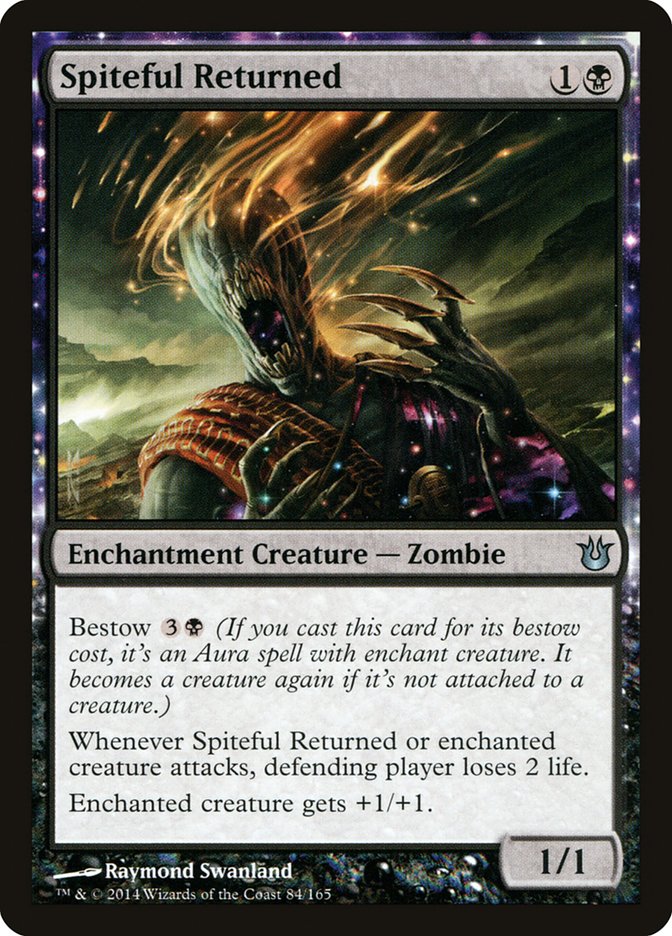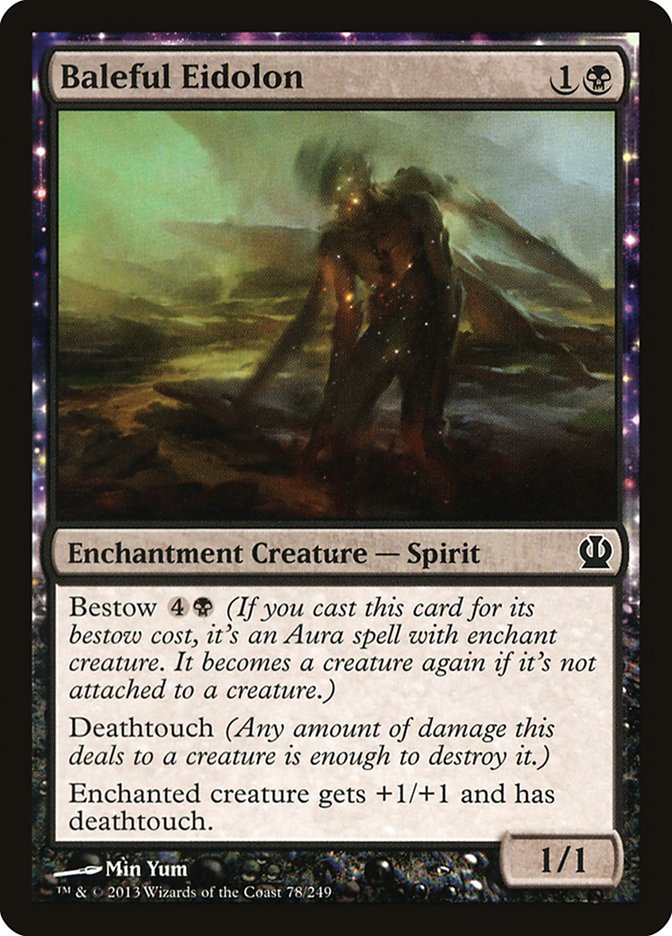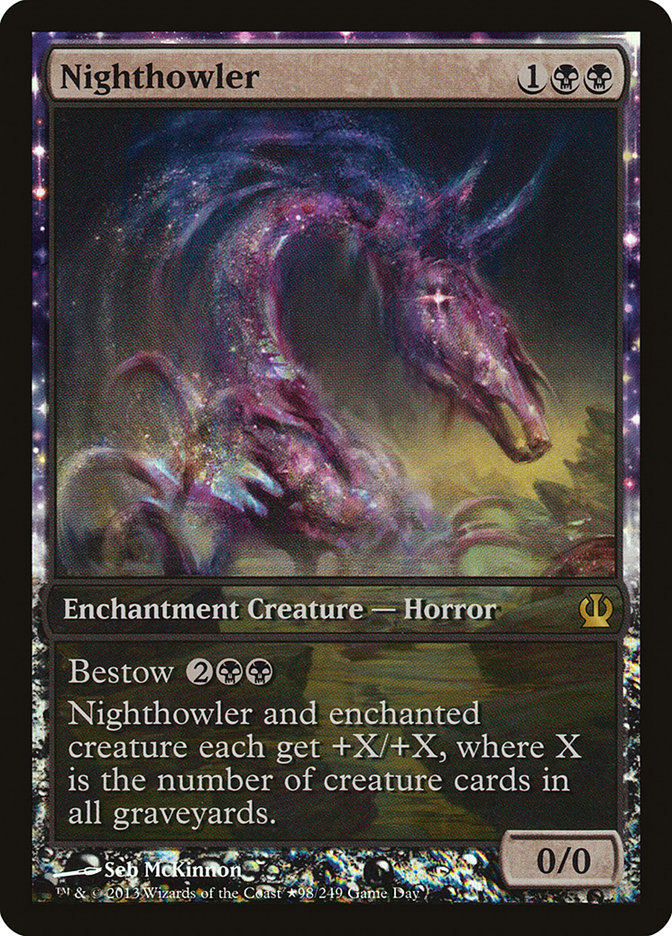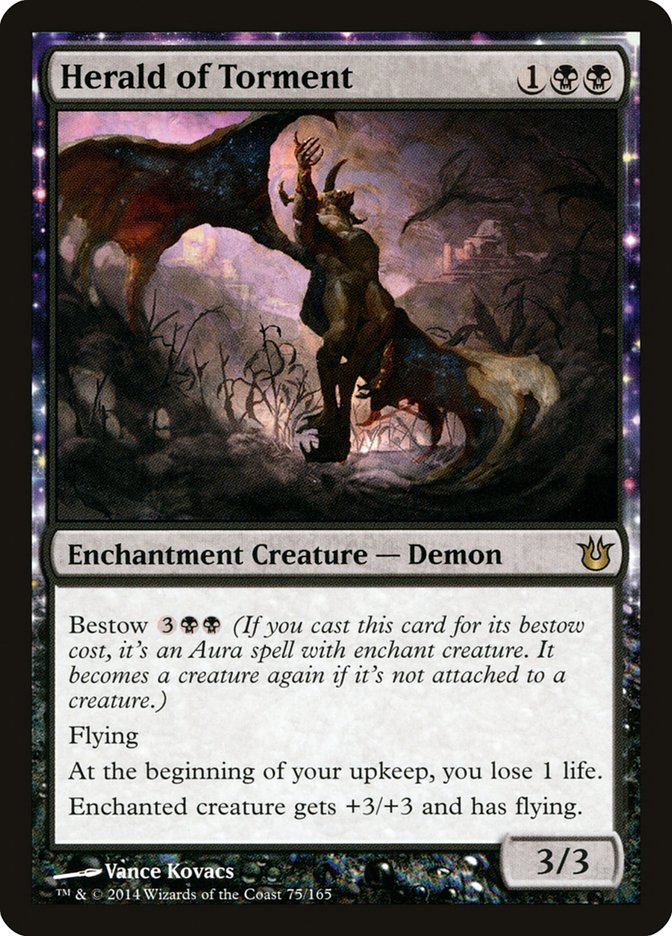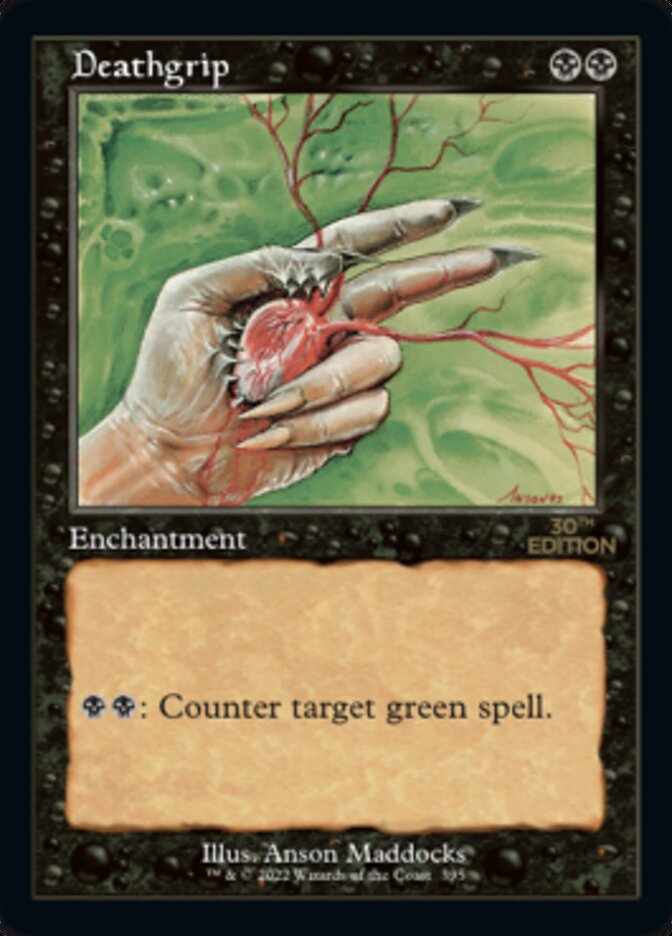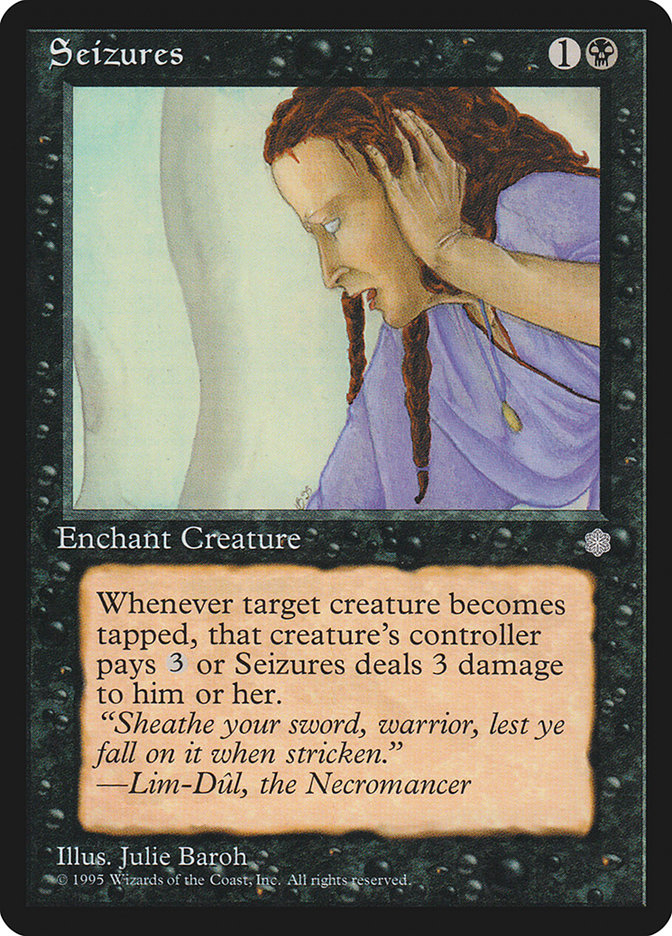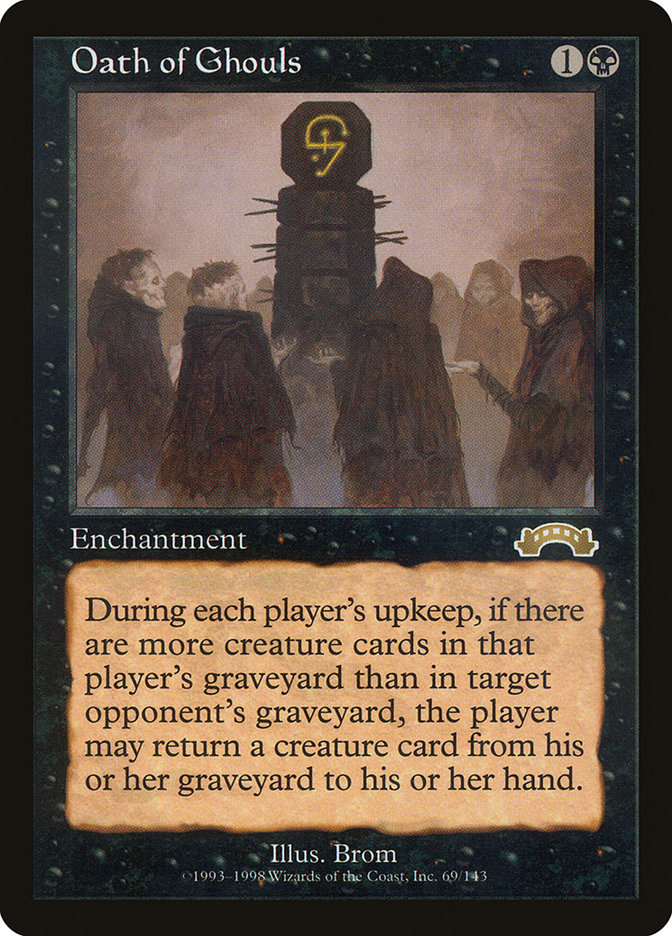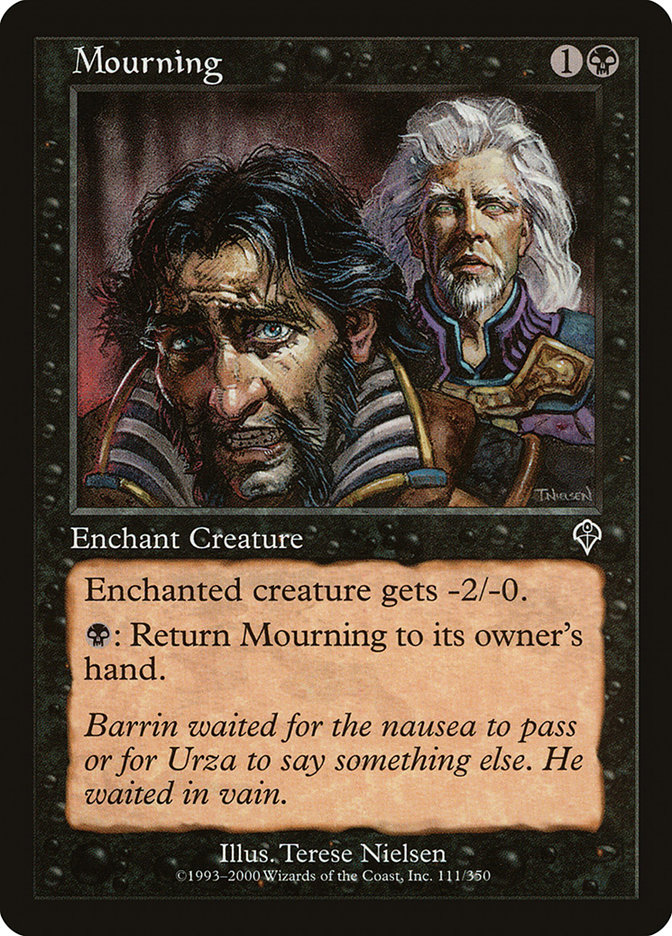Resurgido malévolo Carta MTG
| El coste de maná | |
| Costo de maná convertido | 2 |
| Rareza | Poco común |
| Tipo | Criatura encantamiento — Zombie |
| Habilidades | Bestow |
| Liberado | 2014-02-07 |
| Coleccione símbolo | |
| Coleccione nombre | Born of the Gods |
| Coleccione código | BNG |
| Fuerza | 1 |
| Tenacidad | 1 |
| Número | 84 |
| Frame | 2003 |
| Disposición | Normal |
| Border | Negra |
| Ilustrado por | Raymond Swanland |
Texto de la carta
Concesión {3}{B}. (Si lanzas esta carta pagando su coste de concesión, es un hechizo de aura con encantar criatura. Si no está anexada a una criatura, se convierte en una criatura de nuevo.) Siempre que el Resurgido malévolo o la criatura encantada ataque, el jugador defensor pierde 2 vidas. La criatura encantada obtiene +1/+1.
Cartas similares a Devuelto rencoroso
Devuelto rencoroso destaca en el vasto panorama de criaturas de encantamiento en Magic: The Gathering. Esta encantadora carta puede compararse con otras cartas de Aura como Eídolo funesto que también ofrece un efecto de toque mortal. Sin embargo, Devuelto rencoroso aporta un borde único al permitirte drenar la vida de tu oponente cada vez que la criatura encantada ataca, representando una amenaza persistente.
Otra comparación interesante es con Devorador nocturno, que, al igual que Devuelto rencoroso, se vuelve más potente a medida que las criaturas llenan el cementerio. Mientras que Devorador nocturno otorga un beneficio basado en el tamaño del cementerio, sin embargo, carece de la capacidad de causar directamente la pérdida de vida que convierte a Devuelto rencoroso en una amenaza cada turno. También en esta categoría está Heraldo del tormento, que ofrece tanto el beneficio como el vuelo, pero de nuevo, sin el aspecto de daño directo.
Estas diferencias intrincadas subrayan el papel de Devuelto rencoroso dentro del grupo de criaturas de encantamiento. No destaca en dominar el campo de batalla, sino en su capacidad para erosionar la salud de un oponente, completando estrategias centradas en la atrición y la ventaja incremental en el juego.
Cartas similares a Resurgido malévolo por color, tipo y coste de maná
Aspectos Positivos de la Carta
Ventaja de Carta: Spiteful Returned ofrece una ventaja estratégica a través de su mecánica de otorgamiento, permitiendo a los jugadores potenciar una criatura existente para aumentar su potencial amenaza o desplegarla como una amenaza independiente. Esta versatilidad asegura que los jugadores puedan mantener la presión en el tablero, lo que potencialmente lleva a una utilidad de cartas ventajosa.
Aceleración de Recursos: Aunque Spiteful Returned en sí no contribuye directamente a la aceleración de recursos, puede llevar indirectamente a ganar tempo al obligar a los oponentes a lidiar con la constante pérdida de vida. Esta presión puede llevar a intercambios ineficientes o uso de recursos en el lado del oponente, dando efectivamente al controlador de Spiteful Returned una forma de aceleración de recursos.
Velocidad Instantánea: La capacidad de Spiteful Returned para desencadenar su efecto de pérdida de vida a velocidad instantánea durante las fases de combate crea una forma de interacción que puede interrumpir los cálculos y la planificación de los oponentes. Esto puede llevar a los oponentes a tomar decisiones críticas sobre la marcha, lo que puede ser ventajoso para el controlador de Spiteful Returned.
Aspectos Negativos de la Carta
Requisito de Descarte: Al potenciar una estrategia de descarte propio, Spiteful Returned puede imponer una condición de descarte de cartas gravosa para su función de otorgamiento, reduciendo tu mano y potencialmente tus opciones estratégicas.
Costo Específico de Maná: Requiriendo tanto maná negro para su lanzamiento como para su costo de otorgamiento, Spiteful Returned puede ser menos viable en mazos multicolores que pueden tener dificultades con la consistencia de colores.
Costo de Maná Comparativamente Alto: A pesar de que Spiteful Returned ofrece una ventaja estratégica con su capacidad para drenar vida al atacar, sus costos combinados de lanzamiento y otorgamiento son bastante elevados en comparación con otras criaturas o auras de efectos similares.
Razones para Incluir en tu Colección
Versatilidad: Spiteful Returned puede ser una adición estratégica a varios mazos, especialmente aquellos que giran en torno a la mecánica de devoción o sinergias de encantamientos. Su capacidad para adjuntarse a una criatura como un Aura añade a su flexibilidad en el campo de batalla.
Potencial de Combo: La capacidad de esta carta para infligir daño directamente a un oponente cada vez que la criatura encantada ataca abre posibilidades de combo con cartas que se benefician de la pérdida de vida o que se activan al infligir daño.
Meta-Relevancia: En las circunstancias adecuadas, Spiteful Returned puede encajar en un entorno donde las estrategias agresivas son prevalentes. Su capacidad de daño recurrente respalda una reducción constante de puntos de vida, convirtiéndolo en un arma potente contra mazos más lentos y basados en el control.
Cómo Vencer
Spiteful Returned es una carta intrigante que ofrece a los jugadores en MTG una amenaza persistente con su habilidad de minar la vida total de un oponente. Esta criatura de encantamiento con la mecánica de otorgamiento puede volverse especialmente problemática cuando se adjunta a otra criatura, por lo que es crítico abordarla rápidamente. Para contrarrestar eficazmente a Spiteful Returned, los hechizos de eliminación que pueden manejar tanto encantamientos como criaturas ofrecen un doble golpe, como Erase o Despark dependiendo de tu disponibilidad de maná.
Las limpiezas de tablero son otra táctica poderosa para lidiar con múltiples amenazas, incluyendo Spiteful Returned, asegurando un nuevo comienzo. Settle the Wreckage o Supreme Verdict son excelentes ejemplos de hechizos que pueden eliminar criaturas ya sea otorgadas o independientes. Además, es ventajoso priorizar la eliminación de criaturas a las que pueda otorgar antes de que se active la habilidad de otorgamiento, potencialmente con hechizos a velocidad instantánea como Fatal Push o Path to Exile para minimizar la pérdida de vida y debilitar la presencia en el tablero del oponente.
Combinar una eliminación inteligente con la anticipación estratégica de los movimientos de tu oponente puede disminuir drásticamente el impacto de Spiteful Returned en un juego. Es fundamental adaptarse a la naturaleza duradera de las criaturas otorgadas y gestionar tus recursos de manera efectiva para mantener el control del campo de batalla.
Donde comprar
Si estás buscando comprar una carta MTG Resurgido malévolo de un coleccione específico como Born of the Gods, existen varias opciones confiables que debes considerar. Una de las fuentes principales es tu tienda de juegos local, donde a menudo puedes encontrar paquetes de refuerzo, cartas individuales y mazos preconstruidos de colecciones actuales y pasadas. A menudo ofrecen el beneficio adicional de una comunidad donde puedes intercambiar con otros jugadores.
Para un inventario más amplio, particularmente de colecciones más antiguos, mercados en línea como TCGPlayer, Card Kingdom y Card Market ofrecen amplias selecciones y te permiten buscar cartas de colecciones específicos. Las plataformas de comercio electrónico más grandes como eBay y Amazon también tienen listados de varios vendedores, lo que puede ser un buen lugar para buscar productos sellados y hallazgos raros.
Además, el sitio oficial de Magic suele tener un localizador de tiendas y listas de minoristas para encontrar Wizards of the Productos con licencia costera. Recuerde comprobar la autenticidad y el estado de las cartas al comprarlas, especialmente a vendedores individuales en mercados más grandes.
A continuación se muestra una lista de algunos sitios web de tiendas donde puede comprar las Resurgido malévolo y otras cartas MTG:
 COMPRAR
COMPRAR BurnMana es un socio oficial de TCGPlayer
- eBay
- Card Kingdom
- Card Market
- Star City Games
- CoolStuffInc
- MTG Mint Card
- Hareruya
- Troll and Toad
- ABU Games
- Card Hoarder Magic Online
- MTGO Traders Magic Online
Ver productos MTG
Legalidades
Formatos de Magic the Gathering donde Resurgido malévolo tiene restricciones
| Formato | Legalidad |
|---|---|
| Commander | Legal |
| Legacy | Legal |
| Paupercommander | Restringido |
| Modern | Legal |
| Oathbreaker | Legal |
| Vintage | Legal |
| Duel | Legal |
| Pioneer | Legal |
| Penny | Legal |
Reglas e información
La guía de referencia para las reglas de las cartas Resurgido malévolo de Magic: The Gathering proporciona las reglas oficiales, las erratas emitidas, así como un registro de todas las modificaciones funcionales que se han producido.
| Fecha | Texto |
|---|---|
| 15/09/2013 | Un Aura que se convierte en una criatura ya no se coloca en el cementerio de su dueño como una acción basada en el estado. En cambio, se vuelve desvinculada y permanece en el campo de batalla siempre que sea una criatura. Mientras sea una criatura, no puede ser enlazada a otro permanente o jugador. Un Aura que no esté unida a un permanente o jugador legal según lo definido por su habilidad para encantar y que tampoco sea una criatura se colocará en el cementerio de su dueño como una acción basada en el estado. |
| 15/09/2013 | Las Auras unidas a una criatura no se quedan tapadas cuando la criatura se tapa. Excepto en algunos casos raros, un Aura con devocion permanece sin tapar cuando se desune y se convierte en una criatura. |
| 15/09/2013 | Si una permanente con dotar entra al campo de batalla de cualquier otra forma que no sea lanzándola, será una criatura encantamiento. No puedes elegir pagar el coste de dotar y hacer que se convierta en un Aura. |
| 15/09/2013 | En la pila, un hechizo con cedazo es o un hechizo de criatura o un hechizo de Aura. Nunca es ambos, aunque es un hechizo de encantamiento en ambos casos. |
| 15/09/2013 | A diferencia de otros hechizos de Aura, un hechizo de Aura con la habilidad de otorgar no se contrarresta si su objetivo es ilegal al comenzar a resolverse. Más bien, el efecto que lo convierte en un hechizo de Aura termina, pierde "encantar criatura", regresa a ser un hechizo de criatura encantamiento, resuelve y entra al campo de batalla como una criatura de encantamiento. |
| 15/09/2013 | A diferencia de otras Auras, un Aura con adorno no se coloca en el cementerio de su propietario si se desvincula. En cambio, el efecto que lo convierte en un Aura termina, pierde "encantar criatura" y permanece en el campo de batalla como una criatura encantamiento. Puede atacar (y sus habilidades se pueden activar, si las tiene) en el turno en que se desvincula si ha estado bajo tu control de forma continua, incluso como un Aura, desde que comenzó tu turno más reciente. |
| 15/09/2013 | No eliges si el hechizo va a ser un hechizo de Aura o no hasta que el hechizo ya está en la pila. Las habilidades que afectan cuándo puedes lanzar un hechizo, como destello, se aplicarán al hechizo después de que hayas tomado esta decisión. Por ejemplo, un efecto que diga que puedes lanzar hechizos de criatura como si tuvieran destello no te permitirá lanzar una carta de criatura con don como un hechizo de Aura en cualquier momento en que pudieras lanzar una instantánea, pero uno que diga que puedes lanzar hechizos de Aura como si tuvieran destello sí lo hará. |
